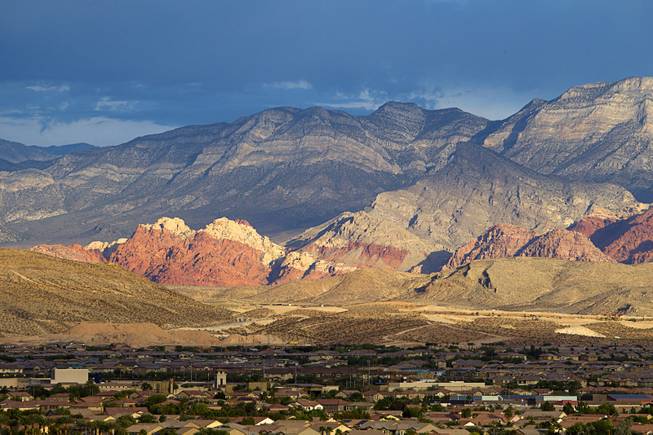
Originally published by Daniel Rothberg, Las Vegas Sun
Read here: https://lasvegassun.com/news/2017/feb/20/save-red-rock-clark-county-commission/
Monday, Feb. 20, 2017 | 2 a.m.
The story begins almost 250 million years ago, with the ocean and geology and gypsum. It starts with the Red Rock Canyon National Conservation Area under an ancient sea, at a time when what is now Utah marked the continent’s coastal boundary.
Movements in Earth’s crust eventually pushed the land up, and when water dried in pocketed lakebeds, it left salt and sometimes gypsum.
Millions of years later, humans found the soft sulfate useful to make wallboard, plaster of paris and classroom chalk, and it is still excavated down the road from Red Rock, following a history of mining activity in the region. But opportunities for commercial activity have diminished since the 1960s, when Congress began withdrawing land for public use to protect an area that drew hikers, bikers and climbers to its rust-toned Calico Hills.
Make your voice heard
Attend the County Commission meeting at 9 a.m. Feb. 22 in Commission Chambers. Proponents or opponents can give public comments, which are not submitted in the official record. The meetings are streamed online.
Much of that protected landscape became the Red Rock Canyon NCA. About 2 million people visit each year, according to the Bureau of Land Management, which oversees the public resource. Its most prominent sight might be the escarpment, an orange face of Aztec sandstone with bands of peach and reddish-brown. The layers are an inverted geologic map of Nevada, the result of a thrust fault that pushed older rocks — some from the ancient ocean — above the more recently formed strata of rusted red.
“We don’t have Lake Tahoe. We have Red Rock,” said U.S. Rep. Dina Titus, D-Las Vegas. “And now you’re putting 5,000 houses up there?”
Titus’ rhetorical question cuts to an issue Clark County has been grappling with for years and is expected to consider at a meeting on Wednesday: whether to approve the plan for a master-planned community of 5,025 homes near Red Rock.
It follows mudslinging from all sides since October, when county planners unanimously recommended denial of the project.
Ahead of the vote, the county is caught between what it sees as two litigious parties and fending off accusations that it is favoring the rights of a well-connected developer over conservation of public lands. It also finds itself inside a maelstrom of precedent in a conflict that dates to 2002. Some commissioners are bracing for the issue to be taken to court, no matter their decision on Feb. 22.
Behind all the legal and political wrangling is a common Western tension, pitting commercial development against a band of conservationists prepared to stop at nothing.
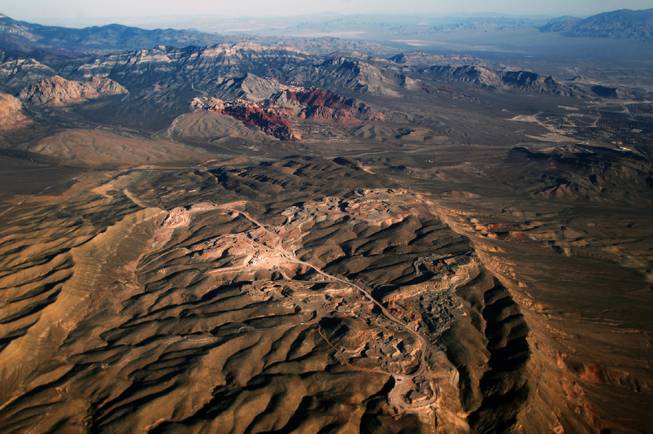
A gypsum mine owned by developer Jim Rhodes, who wants to develop housing on the site, is seen in the foreground while the Red Rock Canyon National Conservation Area is seen in the distance Saturday, Oct. 26, 2013.
‘FIGHT EVERY STEP OF THE WAY’
If the proposed development fell within the conservation area, it would be dead on arrival. The issue here is that those 5,025 homes would sit on private land outside the park, a series of parcels about 5 miles from the Red Rock Canyon Visitor Center that are owned by Southern Nevada developer Jim Rhodes. Testifying before state legislators in 2003, he described the area as “a rough jewel in the desert,” 2,010 acres ideal for a master-planned community.
What’s there now is sunken land, a gypsum strip mine that came online in the 1920s. Rhodes’ company Gypsum Resources, which owns and operates the mine, argues that the rural village of homes, markets, shops and parks — with provisions to mitigate light pollution and traffic — would be the best option to reclaim the shallow pads that pock the land. Conservationists point out that a development so close to Red Rock would destroy what one former BLM lawyer called the “Yosemite of the conservation lands.”
Is it safe to live where a mine once was?
Gypsum requires a relatively noninvasive mining process. It’s extracted from the ground, processed through a rock crusher, pulverized into powder and then shipped off. One-third of the gypsum from the mine near Red Rock Canyon goes to a processing plant down the hill. The remainder goes to California.
Reclamation of a gypsum mine is less intensive than it is for gold and silver mines. The site would need to be regraded to remove mining tunnels before construction can begin on the development, but is otherwise safe.
Plus, the land is zoned for rural development, meaning Rhodes can only build 1,500 homes. To create his vision, he must convince Clark County to change the zoning, something developers have tried for 15 years. Every time, they’ve come up against fierce opposition.
“You have to fight every step of the way,” Titus said. “The further you go down the path, the harder it is to stop.”
In 2003, Titus (then minority leader in the Nevada Senate) shepherded legislation that limited rezoning around Red Rock.
Rhodes, who had purchased the mine not long before that, opposed Titus’ bill. His team said the legislation denied him a way to ask Clark County for the master-planned community. “What I envisioned was a place where working families of all income levels and from every demographic background could live in a neighborhood that blends with the natural beauty of this spectacular place,” Rhodes told legislators, according to minutes from a 2003 Assembly committee. “I’m asking you to give me a chance to show the people of Clark County and elected officials the kind of community I would like to build for them, and let them decide.”
Not a single legislator voted against the restrictions, which required the county to keep the gypsum mine area zoned for lower-density rural development. Titus’ bill had support from the Sierra Club, the Southern Nevada Homebuilders Association, the city of Henderson, the Nevada Conservation League and all but one Clark County commissioner who abstained from voting.
After the restrictions passed, Rhodes took the state and county to court. The developer prevailed (“I think that was a political decision,” Titus said), and the county approved an agreement to consider the project in “good faith.” In 2011, planners and commissioners OK’d Rhodes’ higher-density plan with some limits on light pollution, traffic and density at the development’s edges.
But the project languished. There was even a brief alliance between Rhodes and his opponents. His company and conservationists pushed the BLM to swap the gypsum mine for federal land not adjacent to Red Rock. When the BLM refused the transfer (because the land had been so heavily stripped from mining), the developer tweaked the 2011 plan and filed an amended version last year.
Then something unexpected happened in October.
After two hours of impassioned public comments from activist coalition Save Red Rock, county planners voted to deny the plan. The move stunned both sides. Ron Krater, a spokesperson for the project, was “shocked and surprised.”
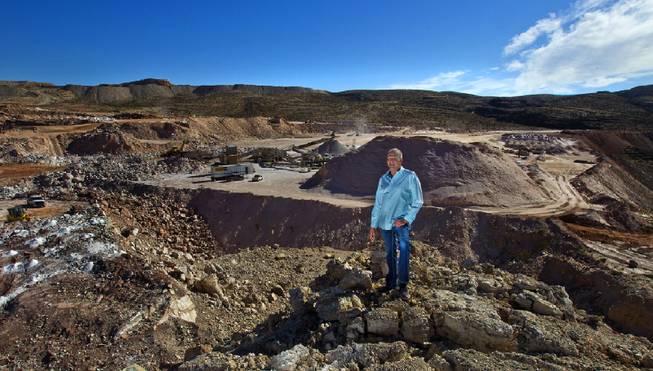
Las Vegas developer Jim Rhodes looks on as gypsum is processed at the Blue Diamond Gypsum Mine near the Red Rock Canyon National Conservation Area on April 16, 2014.
‘THE SITE IS NOT NATURE’
Given the complexity and scope of master-planned communities, conflicts are common, and they often center on where development and backcountry meet. Red Rock was enmeshed in another land-use issue in the 1980s, when the Howard Hughes Corp. was developing Summerlin and exchanged about 5,000 acres near the conservation area with the BLM.
Krater, a lead consultant on Rhodes’ project who speaks at county meetings on his behalf, is no stranger to these conflicts. His résumé includes DC Ranch in Scottsdale, Ariz., Ladera Ranch and the newest villages at Irvine Ranch in Orange County, Calif. In eight years working with Rhodes, Krater has had a good relationship with the community. But he’s frustrated with the discourse.
“We’re not proposing to build a city up on the hill at all,” he said. “That conversation is being hijacked by the Save Red Rock people.”
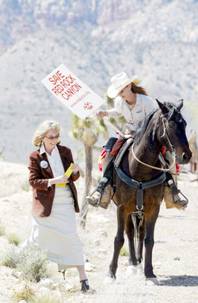
LAS VEGAS SUN FILE
In 2003, Dina Titus — then minority leader in the Nevada Senate — shepherded legislation that limited rezoning around Red Rock Canyon.
Save Red Rock’s resistance has been loud and sustained. The group gathered 36,000 signatures to “Keep Red Rock Rural.” They have billboards on Interstate 215 and ads on KNPR. They have done phone banks and sent cards to commissioners. Their case is simple and easily digestible: Markets, schools and 5,025 dwelling units will destroy Red Rock’s integrity. Support has come from all kinds of outdoor enthusiasts (the cause has even been mentioned in Climbing Magazine and Men’s Journal).
Heather Fisher, who leads the group, runs a bike shop in Summerlin (she includes “Ride Bikes Save Earth!” in the postscript of her emails). She worries that approval of the project could create a slippery slope of rezoning in the region. “It’s the canary in the coal mine.”
Depending on who you talk to, Save Red Rock’s concerns range from light pollution and traffic to ecological and geological impacts, and the fact that gypsum mining will continue as the project is developed.
Krater argues that Save Red Rock has skewed the facts. First, its name: The community would not be in Red Rock; it would be 5 miles away. He also contends that only 10 percent of the project will be visible from the park’s scenic loop. And the Wednesday meeting, he points out, is hardly the end of the planning process. If Gypsum Resources’ concept plan is approved, the developer would still have to submit other materials, including a specific plan, which could be denied.
“We’re not asking for an approval to build anything on Wednesday,” Krater said.
He notes that the most recent plan was scaled back to 5,025 homes from the more than 7,000 proposed in 2011 and 8,400 in 2002 — and that the land is so torn up that the BLM decided it wouldn’t be in the public’s interest to control it.
“The site is not nature,” Krater said. “It is an obliterated site from 80 years of strip mining.”
That doesn’t mean there aren’t valid reasons to block the project, which would be a large development in a part of the valley where there is little. Some argue that the county could see value in extending the buffer around Red Rock — it would protect wildlife patterns and the integrity of the park’s remote character.
Bret Birdsong is a UNLV professor who served as deputy solicitor in the Obama administration’s Interior Department. He called the project a terrible idea.
“It’s a terrible idea for the Clark County Commission,” he said. “Having conservation lands of that caliber on our doorstep is of irreplaceable long-term value to the quality of life of this community.”
‘THE COUNTY IS NOT ON ANYBODY’S SIDE’
“To get a unanimous decision from them was completely unexpected,” Justin Jones, a former state senator and Save Red Rock’s lawyer, said of the Planning Commission’s October recommendation to deny the project.
From there, things took an unexpected legal turn.
Practically, the planning board’s vote meant very little. The seven-member panel is an advisory board for the county commissioners, but it is not the decider. The choice on Wednesday is whether to affirm or ignore the recommendation, but it’s not that simple.
Save Red Rock raised several issues during Planning Commission meetings, laying the groundwork for a lawsuit. Rhodes had sued before. The calculation: If commissioners denied the plan, Rhodes would sue. If they approved the plan, Save Red Rock would sue.
So in closed session, they followed the county attorney’s advice to ask for a court opinion on disagreements over legal technicalities in the planning process, according to multiple county sources. That opinion would give commissioners cover going into the vote, hopefully avoiding another costly five-year lawsuit.
“I don’t want to spend taxpayer money on a long, drawn-out lawsuit,” Commissioner Susan Brager said.
Stages of the approval process
1. The developer submits a concept plan (a broad overview that describes the purpose and scope of the development, often addressing community concerns) to the Planning Commission.
2. The Planning Commission makes a recommendation on the concept plan to the County Commission.
3. If approved, the developer must submit a specific plan (including more details about the project, such as landscaping standards, streetscape and transportation). Like the concept plan, the specific plan must be approved or denied by the County Commission. Approval at this stage does not guarantee that the developer can start building.
Things did not go as planned.
In December, Commissioner Chris Giunchigliani received a call from the Nevada Conservation League. It was her first time being briefed on the contents of the court filing, having not received the complaint before it was filed by the district attorney’s office, which represents the county. The filing also surprised her because it only sought a legal opinion on differences between the county and Save Red Rock, of which she is a member. “I was caught off guard,” she said.
Jones argued that by leaving the developer out of the equation, the county was effectively abandoning its role as an independent party. “It’s a very one-sided complaint in which they adopted the position of the developer wholeheartedly,” he said.
That stance plays directly into the fear of activists within Save Red Rock that, as Fisher says, “the county is fighting for the developer.” They gripe that Rhodes is a power player with the connections to outmuscle the commission and secure rezoning of the land for higher-density residential housing.
The county forcefully denies these claims. “The county is not on anybody’s side,” Commission Chairman Steve Sisolak said, adding that the court opinion was requested on the advice of the board’s attorney.
Among its motions, the county asked the judge to declare that an earlier plan — approved by the commission in 2011 — was still valid. Doing so would have eliminated the need for the commission to vote Wednesday because the project could proceed with prior approval.
The developer’s company, Gypsum Resources, agreed with the county’s assessment in court, and Save Red Rock pushed back. Jones called the county’s move “absurd” because Clark County had taken the position in public documents that the 2011 concept plan had expired.
According to the legal filing and a county spokesman, a court declaration on this disagreement with Save Red Rock could help it avoid future litigation, and ensure it was complying with county code and giving Rhodes’ plan fair consideration, as it promised to do in a previous settlement agreement.
But the filing provided little guidance. A judge denied Clark County’s request for a ruling on the issue in early February because there was ambiguity as to whether the 2011 Concept Plan was still valid. So the commission had to proceed with the meeting Feb. 22 to dig into Gypsum Resources’ 2016 plan.
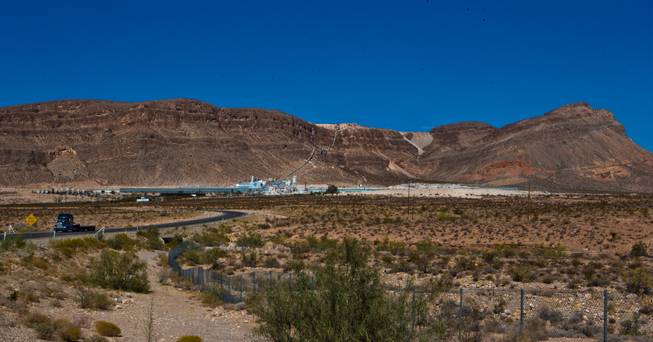
The CertainTeed Gypsum manufacturing facility on Blue Diamond Road near Red Rock Canyon purchases gypsum from the Blue Diamond Hill Gypsum Mine nearby on Tuesday, Oct. 11, 2016. A new road may be installed if developer Jim Rhodes wins his bid to develop the Blue Diamond Hill Gypsum Mine property as a master-planned community.
‘ANOTHER 10 YEARS’
Here’s the thing: Fifteen years have passed, and Rhodes is still pitching his vision to Clark County.
Save Red Rock’s fear that the deck is stacked has so far turned out to be false. In all this time, not a single home has been built on the embattled hill.
The commission makeup has changed since the county last considered the issue, and it’s unclear how members will vote at the zoning meeting. “I do not know where this is going,” Brager said. “I do not make decisions before I get into a meeting.”
Everyone agrees on one thing: This is far from being resolved. If commissioners approve the plan, more hearings and votes will be held, and the development could still be denied. If commissioners don’t approve the plan, the developer could take legal action, arguing that the county did not act in “good faith.”
“It’s been 15 years,” Giunchigliani said, “and it will probably be another 10 years down the road that we’ll have to deal with it.”
In the months ahead, gypsum will continue to be extracted, crushed into rock and pulverized into powder. Nearly one-third will be shipped to a nearby processing plant, while the remainder will go to California’s Central Valley, where the minerals are used in agriculture (gypsum is said to help soil retain water).
This land was not always a development target. Until 2001, Australian-based multinational mining company James Hardie Industries operated the gypsum mine. That year, as housing prices started to boom, it offered the operation to United Kingdom-based John Laing Homes, which introduced the idea of developing a large-scale community there. By 2002, it was asking the county for 8,400 homes on the 2,000 acres. It withdrew zoning plans amid public outcry from conservation groups and the county.
Much of the vitriol now, Krater believes, is the lasting effect of the original plan. “It wasn’t received well at all. It wasn’t appropriate.”
Rhodes purchased the operation in 2003 but didn’t hit the reset button until 2010, Krater said. Soon after, he agreed to a 5,000-home project and made more attempts to reach out to the community.
“We have a great relationship,” Fisher said. “I like Ron (Krater) a lot.”
A great relationship goes only so far. The coalition fighting the project has been successful in getting the developer to scale down and mitigate impact, but they fundamentally oppose any move from current zoning. “You knew what you bought when you bought it,” Giunchigliani said. “How dare you assume that you are entitled to change the zoning.”
That uncompromising position is hard to reconcile with Rhodes’ desire for a higher-density project, one with multi-use housing rather than large single-family ranch homes. The community, built out over two decades, would include trails, stores and a research park with a university and/or an elementary school.
What everyone is forgetting, Krater says, is that under the current rural zoning, the developer could already build 1,500 homes with few restrictions on lighting, landscaping or grading the hill. Better to have restrictions on a larger project than not at all, he argues. Or the developer could continue mining gypsum for at least the next decade, digging deeper and deeper into the land. “Do they really want that?” Krater asked. “My belief is no.”
He added: “(Mining) could take down the whole mountain.”
• • •
ARGUMENTS FOR AND AGAINST THE DEVELOPMENT
Save Red Rock, a coalition of activists and conservation groups, wants the zoning to remain rural, thus limiting the density of any development. The group has received support from nature groups, outdoor athletes and enthusiasts and homeowner associations at nearby master-planned developments, including Summerlin South. A petition for their cause has received 36,000 signatures. Save Red Rock argues that supermarkets, houses, stores and schools so close to Red Rock Canyon would erode the integrity and damage the biota of one of the most pronounced structures in the Mojave Desert. While it’s difficult to tell how the development would affect wildlife, most developments inherently disturb local ecosystems, and this plan could add 10,000-plus cars to Blue Diamond Highway.
What Save Red Rock wants:
1,500 residential units spanning 2,010.6 acres
Zoning: 0.75 home/acre
Concerns:
• It will ruin the secluded character of Red Rock Canyon.
• The project will bring traffic to Blue Diamond Highway.
• Light pollution will emanate from streetlights and headlights.
• Connecting the area to water comes at great cost and difficulty.
• Mining will continue as homes are being built, creating liability for the county.
Ron Krater, a consultant for the development group said that as it stands, “the site is not nature. It is an obliterated site of 80 years of strip mining.” The best way to reclaim the land, he argues, would be to construct a community with a design that is sensitive to the environment. He also stressed that Save Red Rock is a misnomer, since the mine is adjacent to but not within the national conservation area. The new residential community would likely have amenities, such as a school, supermarket and parks. The concept plan allocates about 78 acres to commercial property and another 60 acres to office property. It also allocates about 104 acres to a research park consisting of a university and/or private school.
What the developer wants:
5,025 residential units spanning 2,010.6 acres
Zoning: 2.5 homes/acre
Response to concerns:
• Visible homes at the edge of the project will be lower-density.
• There will be no primary access to the community from Blue Diamond Highway (the access route to Red Rock Canyon).
• They will use dark-skies lighting techniques and neutral color tones.
• The new concept plan removes industrial land uses that were present in the version from 2011.
• • •
PROJECT TIMELINE
2002: United Kingdom-based developer John Liang Homes asks the county for permission to build 8,400 homes on the mine site. It withdraws the plan after public outcry.
March 2003: Jim Rhodes purchases the Blue Diamond Hill Gypsum Mine.
2003: The state of Nevada and Clark County adopt restrictions on zoning near the Red Rock Canyon National Conservation Area, effectively killing plans to build a master-planned community there.
2005: Blue Diamond Hill Gypsum Mine sues Nevada and the county.
2010: The county settles with Rhodes and agrees to cooperate in “good faith.” Nevada continues to defend the restrictions, which are later held unconstitutional in court.
2011: Rhodes submits a concept plan. The Clark County Planning Commission and Board of Commissioners, with several stipulations, approve the project.
2011-2014: The project is on hold as Rhodes pursues a land transfer with the Bureau of Land Management. This would allow the developer to build the project elsewhere.
2014: The BLM denies the land transfer.
July 2016: Rhodes submits an amended concept plan with Clark County. It calls for 5,025 homes, reduces light pollution and mitigates traffic.
Oct. 2016: In a unanimous decision, the Planning Commission recommends that the County Commission deny the concept plan.
Dec. 2016: On behalf of the commission, the District Attorney’s office asks a county court to settle legal questions on technicalities in the concept plan. It lists actions against an activist group, Save Red Rock, but does not name the developer.
Feb. 9: The judge does not grant a motion asking for a legal opinion.
Feb. 22: Commissioners are scheduled to vote on the proposal.

















